
The true finches are small to medium-sized passerine birds in the family Fringillidae. Finches generally have stout conical bills adapted for eating seeds and nuts and often have colourful plumage. They occupy a great range of habitats where they are usually resident and do not migrate. They have a worldwide native distribution except for Australia and the polar regions. The family Fringillidae contains more than two hundred species divided into fifty genera. It includes the canaries, siskins, redpolls, serins, grosbeaks and euphonias, as well as the morphologically divergent Hawaiian honeycreepers.
Located about 2300 miles (3680 km) from the nearest continental shore, the Hawaiian Islands are the most isolated group of islands on the planet. The plant and animal life of the Hawaiian archipelago is the result of early, very infrequent colonizations of arriving species and the slow evolution of those species—in isolation from the rest of the world's flora and fauna—over a period of at least 5 million years. As a consequence, Hawai'i is home to a large number of endemic species. The radiation of species described by Charles Darwin in the Galapagos Islands which was critical to the formulation of his theory of evolution is far exceeded in the more isolated Hawaiian Islands.

The poʻo-uli or black-faced honeycreeper is an extinct species of passerine bird that was endemic to the island of Maui in Hawaiʻi. It is considered to be a member of the Hawaiian honeycreepers, and is the only member of its genus Melamprosops. It had a black head, brown upper parts and pale gray underparts. This bird inhabited only the wetter, easternmost side of Maui, where it had rapidly decreased in numbers. With extinction threatening, efforts were made to capture birds to enable them to breed in captivity. These efforts were unsuccessful; in 2004, only two known birds remained, and since then, no further birds have been sighted. A 2018 study recommended declaring the species extinct, citing bird population decline patterns and the lack of any confirmed sightings since 2004, and in 2019, the species was declared extinct.
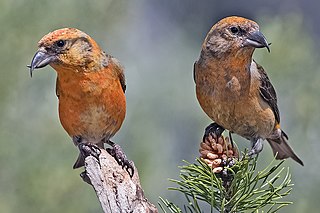
The cardueline finches are a subfamily, Carduelinae, one of three subfamilies of the finch family Fringillidae, the others being the Fringillinae and the Euphoniinae. The Hawaiian honeycreepers are now included in this subfamily. Except for the Hawaiian honeycreepers which underwent adaptive radiation in Hawaii and have evolved a broad range of diets, cardueline finches are specialised seed eaters, and unlike most passerine birds, they feed their young mostly on seeds, which are regurgitated. Besides this, they differ from the other finches in some minor details of their skull. They are adept at opening seeds and clinging to stems, unlike other granivorous birds, such as sparrows and buntings, which feed mostly on fallen seeds. Some members of this subfamily are further specialised to feed on a particular type of seed, such as cones in the case of crossbills. Carduelines forage in flocks throughout the year, rather than keeping territories, and males defend their females rather than a territory or nest.
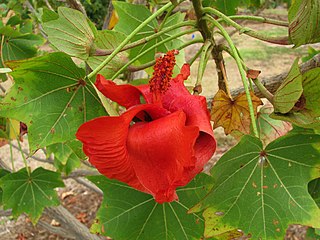
Kokia cookei is a small, deciduous tree commonly known as the kokiʻo, Molokaʻi treecotton, Cooke's kokiʻo, or Molokaʻi kokiʻo.

Akialoa is an extinct genus of Hawaiian honeycreeper in the subfamily Carduelinae of the family Fringillidae. The ʻakialoa species are all extinct, but they formerly occurred throughout Hawaii.

Chloridops is an extinct genus of Hawaiian honeycreeper in the subfamily Carduelinae of the family Fringillidae.

Hemignathus is a genus of Hawaiian honeycreepers in the subfamily Carduelinae of the family Fringillidae. All species are endemic to Hawaii.
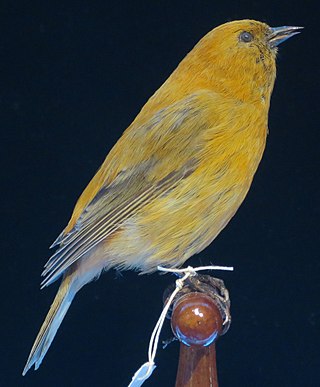
Loxops is a Hawaiian honeycreeper genus in the finch family, Fringillidae. Most of them are commonly known as ʻakepa.
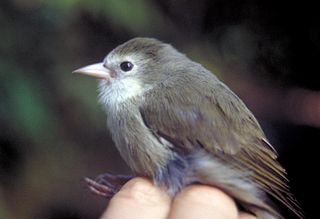
The ʻakikiki, also called the Kauaʻi creeper, is a critically endangered Hawaiian honeycreeper endemic to Kauaʻi, Hawaiʻi. It is the only member of the genus Oreomystis. Of the Hawaiian birds known to be extant, it is thought to be the most endangered, with only 454 wild individuals known as of 2018. A survey report in 2021 estimated the population at 45 with a 5 percent annual decrease, and in July 2023 the remaining number of wild birds was estimated to be just 5 individuals. This species is predicted to be extinct in the wild in 2023.

The ʻākohekohe, or crested honeycreeper, is a species of Hawaiian honeycreeper. It is endemic to the island of Maui in Hawaiʻi. The ʻākohekohe is susceptible to mosquito‐transmitted avian malaria and only breeds in high‐elevation wet forests.

The kākāwahie or Molokaʻi creeper is an extinct species of Hawaiian honeycreeper. It was found on the Hawaiian island of Molokaʻi in Hawaii.

The Oʻahu ʻalauahio, also known as the Oʻahu creeper, is a small finch-like Hawaiian honeycreeper that is endemic to the Hawaiian island of Oahu. It is probably extinct.

The Maui ʻalauahio, also known as the Maui Nui ʻalauahio or Maui creeper, is a species of Hawaiian honeycreeper. It is endemic to Maui Nui, Hawaii. The name Maui ʻalauahio is somewhat misleading because the species seems to have occurred on most, if not all, parts of the ancient Maui Nui, which includes the present day islands of Maui, Molokaʻi, Lānaʻi, and Kahoʻolawe. There are two subspecies: the Lānaʻi ʻalauahio, P. montana montana, which occurred on Lānaʻi (extinct); and P. montana newtoni which occurs on Maui. The common name refers to both groups.

Rhodacanthis, commonly known as the koa finches, is an extinct genus of Hawaiian honeycreeper in the subfamily Carduelinae of the family Fringillidae. All four species were endemic to Hawaii.

The Lānaʻi ʻalauahio is an extinct subspecies of Hawaiian honeycreeper, found on much of the island of Lana'i in the Hawaiian archipelago. It apparently was common until the early 1900s, when there appeared to have been a steep decline in birds on the island. It was similar to the Maui alauahio and this species may have reacted similarly to its existing relative, to which it was considered conspecific. This bird was one of several to vanish from Lana'i, along with others such as the Lanai hookbill.
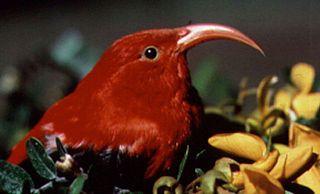
Hawaiian honeycreepers are a group of small birds endemic to Hawaiʻi. They are members of the finch family Fringillidae, closely related to the rosefinches (Carpodacus), but many species have evolved features unlike those present in any other finch. Their great morphological diversity is the result of adaptive radiation in an insular environment. Many have been driven to extinction since the first humans arrived in Hawaii, with extinctions increasing over the last 2 centuries following European discovery of the islands, with habitat destruction and especially invasive species being the main causes.
















